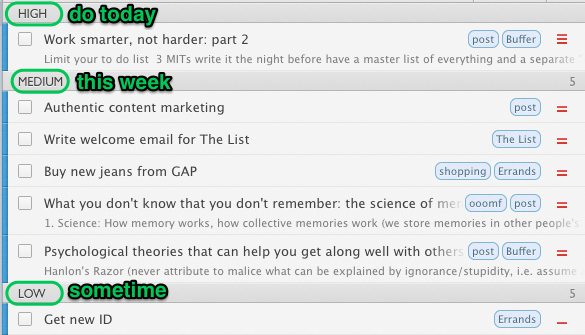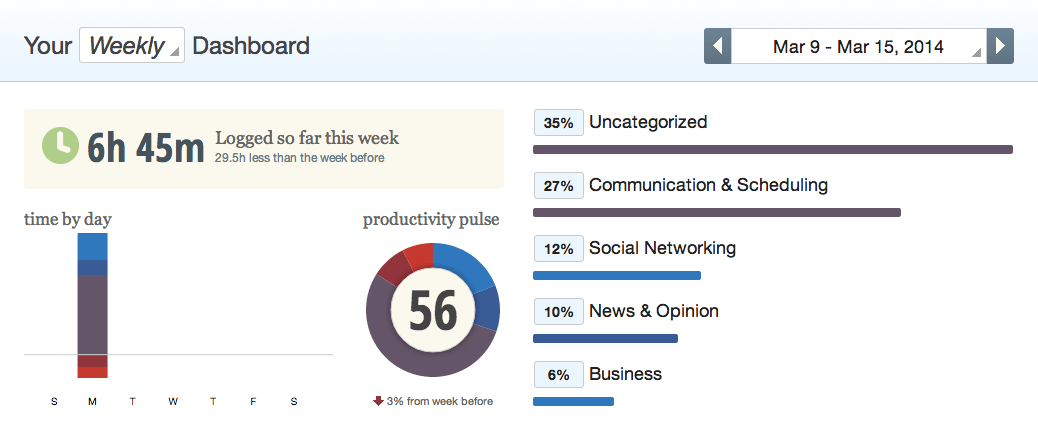I wrote a post recently about ways that you can work smarter, not harder. As I worked through the list of techniques I’d collected, the post became so long that I had to split it in half. Here are even more suggestions to help you make your day more productive without putting in extra hours.
1. Limit your to-do list
I’ve written about the history of the to-do list before, and how to write a great one. One of the most counterintuitive but effective methods I’ve found for increasing my productivity is to limit how many items I add to my to-do list.
One way to do this is by choosing 1–3 Most Important Tasks (MITs). These are the big, tough tasks for your day that you really need to get done. The ones that will keep you in the office past finishing time or working after dinner if you don’t get through them. Leo Babauta advocates doing these before you move on to other tasks:
“Do your MITs first thing in the morning, either at home or when you first get to work. If you put them off to later, you will get busy and run out of time to do them. Get them out of the way, and the rest of the day is gravy!”
The rest of your to-do list can be filled up with minor tasks that you’d like to do, so long as you’ve prioritized 1–3 MITs. Make sure you work on these before you move on to anything minor and you’ll probably find you feel a whole lot more productive at the end of the day.
Plan the night before
Another to-do list tip that can reduce work anxiety is to write out your to-do list the night before. I often end up in bed thinking about what I need to do tomorrow and planning my day, which makes it difficult to sleep. Writing out my to-do list before I go to bed helps me to relax and sleep better. And rather than wasting time in the morning because I don’t know what to work on first, I can jump straight into my first MIT the next day.
Focus just on the present day
My most recent and favorite change to my to-do list has been separating my “today” list from a master list of everything I need to get done.
I often feel anxious about all the things I know I need to do at some point — I need to write them down somewhere so I don’t forget them, otherwise I worry about when they’ll get done. But I don’t want these cluttering up my list for today. That will just make today seem busier than it is.
My solution is to make a big list of everything I need done. Each night I move only a couple of things to my to-do list for the next day (I use one big list with priority markers so that anything “high” priority moves to the top and becomes my “today” list). That lets me focus on what needs doing today, but also gives me a place to dump every little task I think of that needs doing sometime.

2. Measure your results, not your time
The whole idea of working smarter, rather than harder, comes from the problem many of us have of putting in more and more hours, only to find we don’t get more done. We want to find methods of being more productive in less time. One way to go about this is to adjust the way we measure productivity.
It sounds like a trick, but it’s not a way out of getting work done. It’s just that if you truly measure what you get done, rather than the time it took you, you should notice a difference in how you work, as well.
If you have big projects or tasks to get done, a good place to start is by breaking them down into completable sections. For instance, I like to break down my blog posts into sections and small tasks like adding images.

With a set of smaller tasks making up a big project, you can check off what you get done each day, even if it takes you many days to finish the whole thing. I get a nice little rush every time I check off a task within a blog post, even if it was just a 200-word section. It helps me to maintain momentum and keep going until the whole post is done.
Another way to measure what you get done each day is to keep a “done list”, which is a running log of everything you complete in a day. I scoffed at done lists for a long time until I joined Buffer, where we all share what we’ve done each day using iDoneThis:

If you start keeping a list of everything you get done in a day, you might be surprised how much more motivated you are to do work that matters and get lots done.
3. Build “getting ready to work” routines
As I mentioned earlier, if I don’t know what to work on first, I tend to procrastinate and waste time in the mornings. You might have a different danger time for procrastination, but getting started seems to be a common hurdle. One way to make it easier to get started is by building a routine that tells your brain and body it’s time to work.
Your routine could be something as simple as your daily commute or grabbing a coffee on the way to work. I usually sit at my desk with my coffee and check up on my favorite sites to see if there’s any news. Once my coffee is finished, that’s my cut-off point. It’s my trigger to start working.
Other ways to get into a working mindset can include sitting down at your desk or workspace, turning off your phone or putting it away, exercising, stretching, or eating breakfast. You could even have an album or playlist that gets you in the mood to work and listen to that as part of your routine.
Make a weekend routine, too
Although you might be tempted to let go of your routine entirely on your days off, our CEO Joel has found that maintaining a weekend routine that doesn’t differ too much from his weekdays has worked well. The more he let go of his routine on the weekends, the longer it took him to pick it up again during the week.
4. Track what you’re wasting time on
If you’re struggling with productivity, it can be tempting to start changing your routine or trying new solutions before you uncover the real problem. I’ve definitely done this in the past, and found it never leads to a long-term solution.
The first step in becoming more productive is working out what your regular time-sucks are. To start with, track what you do every morning to get ready for work. You might find that you’re spending time on things like choosing your clothes for the day, which could be done the night before. Then track how you spend your time during the day and look for patterns – a tool like RescueTime can help. Perhaps you’ll find that you’re getting caught up on Facebook too often.

Once you know what’s taking up your time or leading you to procrastinate, you can start to make specific changes around those habits.
Something I used to waste a lot of time on in the mornings was checking out my favorite sites for news or updates. This is something I’ve factored into my routine now: I do this while I drink my coffee, and I know that when the coffee is gone, work has to start. This way I still get to do the thing I like, but I don’t let it get out of hand or cut into time I’ve planned for work. Plus, I’ve automated the process of opening them up, cutting back on time spent remembering which sites I want to visit and typing them into my browser.
5. Build habits to help you stop working
This one might seem a bit strange, but I think it can really work. Some of us struggle most in stopping work, rather than (or as well as) getting started. It can sometimes be too easy to just keep going for another hour, or to get your computer out after dinner and get stuck working until well after bedtime. The worst thing about these habits is that they encourage us to put off our MITs in the morning, since we know we’ll end up working for long enough to get them done.
There are a few ways to help yourself switch off at home time and leave work behind. Hopefully, if you start implementing these, you’ll find that you’re pushed to do your most important work first thing rather than putting it off, and you’ll become more productive overall.
Quit while you’re ahead
The best way is always to stop when you are going good and when you know what will happen next. If you do that every day … you will never be stuck. — Ernest Hemingway
This is common advice for writers, in particular, but it can apply to all kinds of work. Many famous writers have said that stopping mid-sentence or mid-paragraph makes it much easier to pick up the pen again the next day.
You don’t go on writing and writing until you come to the end of it, because when you do, then you say, well, where am I going to go next? You make yourself stop and you walk away. And you can’t wait to get back because you know what you want to say next. — Roald Dahl
Set a firm cut-off time
Sean Ogle wrote a great post about this idea. He has a strict cut-off time of noon most days, which is pretty extreme. You could make this work with an evening cut-off time, though, to get you out of work by, say, 5 p.m.
Sean gets up early, so he has 5–6 hours of work time before his midday cut-off point. But since he’s strict about stopping work at noon, he still needs to be ruthless with prioritizing his tasks:
I know that by the time mid-day hits, my energy is going to start to wane. At that time, it’ll be much more difficult to do anything I don’t want to do, so I always try and do the hardest or most valuable items first.
Another way to try limiting your time is to work on your laptop without the power cord. This limits you to however long your battery lasts, and I’ve found it’s a good motivator to get important things done more quickly.
Plan something for after work
Another tip from Sean’s blog post is to plan an activity or event for after work. In Sean’s case, he plans to catch up with friends or attend events around 12:30 or 1 p.m., which helps to reinforce his noon cut-off time.
If you’re aiming to get out of the office around 5 p.m., you might set up a dinner date, a quick after-work drink with a friend or a family visit. External forces can sometimes be the motivation you need to get things done within the time you have, rather than letting them drag out.
I also like the feeling of having something fun to look forward to when I’m finished with work. Sometimes it’s even better when this is a flexible appointment, like some shopping or visiting a friend, so that I’m motivated to get my work done even faster to get to that reward.
Create a wind-down routine
Having a routine to help you wind down from work can be helpful if you tend to struggle to switch off. I’ve always found light exercise works well, so walking home from the office or taking a walk after work is a habit I like doing. Our CEO Joel goes for an evening walk as part of his going-to-bed routine, since it’s such a good winding-down activity.
Journalling can be really relaxing, as can talking through your day with a partner or friend. Something Benjamin Franklin used to do was ask himself every night, “What good have I done today?” Writing about your day can be a good way to reflect and keep a log of what you’ve done, as well as transitioning out of your work mode.
If you’re getting into the habit of planning your day the night before, this can be a good way to cap off your workday. Pick out your MITs for tomorrow and plan a task list so you can relax once you leave work.
If these things aren’t enough to help you get up and go home, you may want to try an alarm to stop work. Alarms to go to bed on time can be as effective as morning alarms to wake us up, so why not try one to remind you to stop working?
What else works for you to increase your productivity without putting in more hours? Let us know in the comments.
If you liked this post, you might also like The Daily Routines of 7 Famous Entrepreneurs and How to Design Your Own Master Routine and 5 Unusual Ways to Start Working Smarter, Not Harder, Backed by Science.
Image credits: Rob Warde
Try Buffer for free
180,000+ creators, small businesses, and marketers use Buffer to grow their audiences every month.
Related Articles

Learn why social media monitoring matters — and pick one of the seven tools from this list to never miss a brand mention again.

We've rounded up 26 free Instagram tools for creators, marketers, and small businesses

With the newsletters on this list, you'll be able to stay on top of all developments in social media and learn from amazing experts